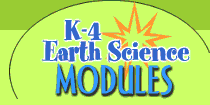Hands-on Activities: Local Four Seasons
Grade Level 3-4
Essential Question How are Earth's spheres in your area changed when the seasons change?
Objective Students should learn how nature changes during the four seasons of the year.
Materials a story about the four seasons (perhaps Barnaby: Seasons in the Park by Wendy W. Rouillard), chalkboard and chalk, paper, pencils, and crayons
Approach Read a story about the four seasons. Ask your students some of the things they see at different times of year. Ask them to describe the water, air, land, and living things in your area during each season. Record their answers on the chalkboard. Instruct the students to group those ideas into four categories of things that happen at the same time. They should use the seasonal categories: winter, spring, summer, and autumn. They should then divide the things in each season into five groups: water, air, land, plant life, and animal life. Instruct the students to draw a table like the one below and fill it with pictures of or words describing the different things in each group (water, air, etc.) during each season (spring, summer, etc.).
Local Season Summary
| |
Water |
Air |
Land |
Plant Life |
Animal Life |
| Spring |
 |
 |
 |
 |
 |
| Summer |
 |
 |
 |
 |
 |
| Autumn |
 |
 |
 |
 |
 |
| Winter |
 |
 |
 |
 |
 |
With your help the students can write or draw a story using the ideas they listed above for each season. They should act out the story as a pantomime production. They should make props such as raindrops, snowflakes, buds, flowers, icicles, etc., and hold them as they perform the play. You can narrate it.
Reflection Students can create a story box to display their understanding of seasonal cycles. To do this, each student will fold a large sheet of paper into fourths and label the four boxes winter, spring, summer, and autumn.
Ask the students to draw one picture in each box of something they listed or saw in the play performed for the class that represents that season. Students should then share their ideas in response to your prompt to talk about all the things that they drew in their boxes. The students should respond individually by showing their pictures and explaining what they drew and why.
Content for this activity provided by Dr. Carol Hochman. |











